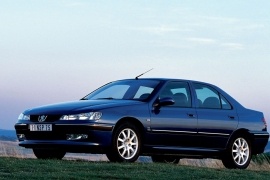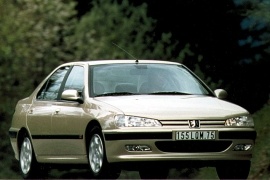PEUGEOT 406 Models/Series Timeline, Specifications & Photos
First production year: 1995
Engines: Gasoline, Diesel
After four years on the market, the 406 model needed a refresh, and Peugeot worked hard to offer a better vehicle to its customers.
After the mid-90s, European customers started to pay more attention to safety rankings. It was an area where the 1995 Peugeot 406 didn't shine with its one-and-a-half star out of five. Its main competitor, the Renault Laguna, managed to get two-and-a-half stars, and that made the Peugeot engineers concerned and the management angry. The revised 1999 model received three stars.
The revised version was not only safer but even better-looking. Its new headlights with clear headlights and an aggressive look were more on the European's tastes. A broad lower grille in the apron flanked by the fog lights evoked a sporty spirit and, for some versions, it was true. The taillights were completely red at the back, with almost undetectable clear areas for the reversing lights.
Inside, the redesigned dashboard featured a new center stack with a wider digital panel for the climate control system. For the instrument panel, Peugeot re-arranged the numbers on the tachometer and introduced a display in the middle, unlike its predecessor, which featured harder-to-follow LCDs.
Under the hood, the carmaker improved the engine lineup. The most potent version received a 210 V-6, while for the fuel-efficient version Peugeot installed the latest, common-rail turbo-diesel engines ranged between 90 hp and 136 hp. Its independent suspension in all corners was an important selling argument, especially against the Renault Laguna.
PEUGEOT 406 1.8L 16V 4AT (112HP)
PEUGEOT 406 1.8L 16V 4AT (117 HP)
PEUGEOT 406 1.8L 16V 5MT (112HP)
PEUGEOT 406 1.8L 16V 5MT (117 HP)
PEUGEOT 406 2.0L 16V 4AT (138 HP)
PEUGEOT 406 2.0L 16V 5MT (138 HP)
PEUGEOT 406 2.0L 16V HPI 5MT (143 HP)
PEUGEOT 406 2.2L 16V 5MT (160 HP)
PEUGEOT 406 3.0L V6 24V 4AT (194 HP)
Peugeot introduced the 406 lineup in 1995 as a replacement for the successful but aging 405, and it was a very important step in the carmaker's design language evolution.
Changing from the wedged shapes of the '80s to the fluid lines of the bio-design era was not easy for the French carmaker. And yet, it succeeded, and even though it somehow resembled the proportions of its predecessor, it offered a completely new design philosophy.
The 406 managed to get on top of European customers' preferences thanks to its design, which was clean, with simple lines, but with a flowing, appealing appearance. Its headlights mimicked an angry look but were not too aggressive. They flanked the slim grille crossed by a horizontal slat where the chromed lion badge took center stage. To increase the cooling area, the carmaker installed an additional, smiling-looking grille in the lower apron. The 406's profile showed an ascending line, ended on a short deck at the back.
Inside, the carmaker continued the flowing-line language with a curved dashboard and a four-dial instrument panel. In addition to those, an LCD was used for the odometer. On the center stack, Peugeot installed a pair of vents, the HVAC controls, and, at the bottom, the stereo. The front bucket seats were designed for comfort, with little bolstering, while at the back, the bench was fit for three passengers, with an average-sized center tunnel.
Under the hood, Peugeot installed a choice of gasoline and turbo-diesel engines. While the former didn't excel in the performance area, the oil-burners were highly fuel-efficient. For those in a hurry, Peugeot also offered a 3.0-liter V6 powerplant. While most versions came fitted with a five-speed manual, some of them were also available with four-speed automatic transmissions.
PEUGEOT 406 1.6L 5MT FWD (90 HP)
PEUGEOT 406 1.8L 16V 4AT FWD (112 HP)
PEUGEOT 406 1.8L 16V 5MT FWD (112 HP)
PEUGEOT 406 1.8L 5MT FWD (90 HP)
PEUGEOT 406 2.0L 16V 4AT FWD (135 HP)
PEUGEOT 406 2.0L 16V 5MT FWD (135 HP)
PEUGEOT 406 2.0L Turbo 5MT FWD (150 HP)

